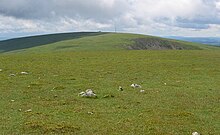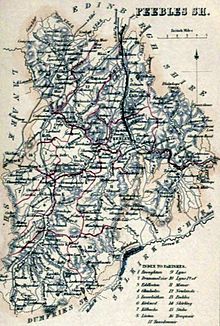Historic county in Scotland
| Peeblesshire | |
|---|---|
| Historic county | |
 | |
| Country | Scotland |
| County town | Peebles |
| Area | |
| • Total | 548 sq mi (1,419 km) |
| Ranked 16th of 34 | |
| Chapman code | PEE |
Peeblesshire (Scottish Gaelic: Siorrachd nam Pùballan), the County of Peebles or Tweeddale is a historic county of Scotland. Its county town is Peebles, and it borders Midlothian to the north, Selkirkshire to the east, Dumfriesshire to the south, and Lanarkshire to the west.
History
The origins of Peeblesshire are obscure, but it became a shire sometime around the twelfth century, covering part of the historic district or province of Tweeddale. The southern part of Tweeddale became the sheriffdom of Selkirkshire, also known as Ettrick Forest, whilst the northern part of Tweeddale was initially divided into two sheriffdoms, based at Peebles and Traquair, before those two were united as the single shire of Peebles, or Peeblesshire, around 1304. From then on the shires gradually became the more important areas for administration; the old provinces were not abolished as such, but their importance diminished.

Peeblesshire County Council was created in 1890 under the Local Government (Scotland) Act 1889, which established elected county councils across Scotland. The council held its first meeting on 22 May 1890 at the courthouse on High Street in Peebles, also known as County Hall, which had been built in 1844–1848 as a sheriff court and meeting place for the Commissioners of Supply, the main administrative body for the county prior to the creation of the county council.

The county council continued to be based at the courthouse until 1935 when it moved to County Buildings on Rosetta Road in Peebles.
Peeblesshire County Council was abolished in 1975 under the Local Government (Scotland) Act 1973, which reorganised local government in Scotland into upper-tier regions and lower-tier districts. Peeblesshire became part of the Borders region and Tweeddale district, the latter having the same boundaries as the pre-1975 county of Peeblesshire. The last lord-lieutenant for the county of Peeblesshire became the first Lord Lieutenant of Tweeddale.
The Borders region and its four districts, including Tweeddale, were abolished in 1996, merging to form the present Scottish Borders council area. The area of the pre-1996 Tweeddale district (and therefore the same area as pre-1975 Peeblesshire) continues to be used as a lieutenancy area under the name of Tweeddale.
Coat of arms
The coat of arms of the county, which was matriculated by the Lord Lyon in 1931, ia as follows: Quarterly, 1st sable five fraises (strawberry leaves) argent; 2nd azure, a horse's head couped argent; 3rd vert, a fleece or; 4th or, fretty gules, on a chief embattled of the last, two thunderbolts of the first. The arms are supported by two salmon proper, and the crest is a Border cavalryman. The motto is ONWARD TWEEDDALE. The first quarter is the arms of Fraser of Oliver Castle, a prominent local laird; the second, that of Horsburgh, another prominent local laird; the third, a reference to the area's wool industry; and the fourth, that of M. G. (later Sir Michael) Thorburn of Glenormiston, who was sheriff of Peebles at the time of the arms' matriculation.
Geography


The county is landlocked and forms part of the Southern Uplands geographic region of Scotland. There are few settlements and the county consists mostly of low hill country, including parts of the Pentland Hills and Moorfoot Hills, with the highest point being Broad Law at 840 m (2,760 ft). The river Tweed is the chief river, flowing in a crescent shape through the county. Bodies of water in Peeblesshire include the Baddinsgill Reservoir, West Water Reservoir and Portmore Loch in the north and the Megget Reservoir, Talla Reservoir and Fruid Reservoir in the south.
Transport

The county was formerly served by the Peebles Railway and the Symington, Biggar and Broughton Railway, however these lines closed in the 1950s-60s and there are now no active railways in the county.
Settlements
- Blyth Bridge
- Broughton
- Cardrona
- Carlops
- Drumelzier
- Eddleston
- Innerleithen
- Kilbucho
- Kingledoors
- Kirkbryde
- Lyne
- Mossfennan
- Peebles
- Polmood
- Romannobridge
- Skirling
- Stanhope
- Traquair
- Tweedsmuir
- Walkerburn
- West Linton
Civil parishes

- Broughton, Glenholm and Kilbucho (union of Broughton, Glenholm and Kilbucho in 1794)
- Drumelzier
- Eddleston
- Innerleithen
- Kirkurd
- Linton or West Linton
- Lyne (formerly Lyne and Megget; Megget, an ancient parish which was united to Lyne in 1621, was transferred to the Selkirkshire parish of Yarrow in 1891)
- Manor
- Newlands
- Peebles
- Skirling
- Stobo
- Traquair
- Tweedsmuir (separated from Drumelzier in 1643)
The parish of Kailzie existed until 1674, when it was suppressed, parts going to Innerleithen and parts going to Traquair.
Community councils
Community councils:
- Carlops
- Eddleston
- Innerleithen and District
- Lamancha, Newlands and Kirkurd
- Manor, Stobo and Lyne
- Royal Burgh of Peebles and District
- Skirling
- Tweedsmuir
- Upper Tweed
- Walkerburn
- West Linton
Gallery
-
Stobo Castle
-
 Innerleithen
Innerleithen
-
 Blyth Bridge
Blyth Bridge
-
 Ruins of Kilbucho Church
Ruins of Kilbucho Church
-
Barony Castle in Eddleston, which contains the Great Polish Map of Scotland
-
 Bridge over the Tweed at Peebles, the county town
Bridge over the Tweed at Peebles, the county town
-
 Neidpath Castle in Peebles
Neidpath Castle in Peebles
References
- "Genuki - Peeblesshire".
- Chalmers, William (1864). A History of Peeblesshire. Edinburgh: William and Robert Chalmers. p. 49. Retrieved 18 December 2022.
- "Scottish Counties and Parishes: their history and boundaries on maps". National Library of Scotland. Retrieved 18 December 2022.
- "Peebles County Council". Peeblesshire Advertiser. Peebles. 24 May 1890. p. 2. Retrieved 18 December 2022.
- Historic Environment Scotland. "The Court House, including former jail and boundary wall to rear, High Street, Peebles (LB39185)". Retrieved 18 December 2022.
- Historic Environment Scotland. "Tweedale District Council Offices, Rosetta Road, Peebles (LB39256)". Retrieved 18 July 2021.
- "Part II: 1900 - 1950 History of Peebles". p. 76. Retrieved 18 July 2021.
- "Local Government (Scotland) Act 1973", legislation.gov.uk, The National Archives, 1973 c. 65, retrieved 22 November 2022
- "The Lord-Lieutenants Order 1975", legislation.gov.uk, The National Archives, SI 1975/428, retrieved 27 November 2022
- "Local Government etc. (Scotland) Act 1994", legislation.gov.uk, The National Archives, 1994 c. 39, retrieved 16 December 2022
- "The Lord-Lieutenants (Scotland) Order 1996", legislation.gov.uk, The National Archives, SI 1996/731, retrieved 16 December 2022
- Urquhart, R.M. Scottish Burgh and County Heraldry. Heraldry Today. p. 232. consulted 19 December 2013.
- "The Imperial gazetteer of Scotland; or, Dictionary of Scottish topography".
- "Broughton". www.bordersfhs.org.uk. Retrieved 30 January 2021.
- GENUKI. "Genuki: Tweedsmuir (parish), Peebles-shire". www.genuki.org.uk. Retrieved 30 January 2021.
- "Kailzie". A vision of Britain.
- Scottish Borders Council: Scheme for the Establishment of Community Councils (under Local Government etc. (Scotland) Act 1994) www.scotborders.gov.uk/info/20015/your_council/643/community_councils retrieved June 2016
External links
![]() Media related to Peeblesshire at Wikimedia Commons
Media related to Peeblesshire at Wikimedia Commons